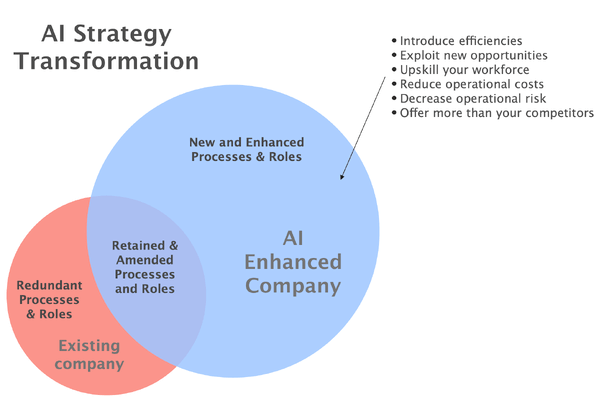In my third article on AI, I delve into the current status of AI and the job market and look into the future to consider how jobs will be lost, augmented and created. I also look at how we can best protect ourselves from the adverse impact of AI and automation.
“AI won’t take your job, but someone using AI just might…”
Today’s Market
AI is creating such a contrived situation for us to cope with. While we look forward to a multitude of exciting opportunities, what will be the point if we lose our jobs? The latest acronym, FOBO – fear of becoming obsolete is a real thing already and while this has always been a concern for automation susceptible roles, AI has compounded that risk and now affects almost all occupations.
The International Monetary Fund (IMF) reports the impact of AI on employment will be pronounced in advanced economies, affecting up to 60% of jobs including some highly skilled roles.
But does it have to be this way? Is there a way we can ride the crest of the AI wave and safely arrive at the shore without being swallowed by the waves of ‘progress’? Let’s dive in and sea (sorry, no more Dad jokes from here on!… 😁)
Displaced roles
Roles rendered redundant through automation, increased speed, reduced costs and optimisation.
The looming threat of AI is already having an impact on jobs, beyond the obvious loss of cashiers to the increasingly ubiquitous self-service checkouts, let’s have a look at some high profile recent job losses.
Both Salesforce and SAP have reportedly laid off employees as part of restructuring efforts. Salesforce is reducing its workforce by around 700 people, while SAP is cutting approximately 8,000 jobs.
Google CEO Sundar Pichai recently warned employees to brace for further layoffs as part of the company’s reallocation of resources towards artificial intelligence. In early 2024, Alphabet, Google’s parent company, announced layoffs affecting about 1,000 employees in its hardware and search units. A report suggested that Google’s AI-related layoffs could potentially impact up to 30,000 employees, primarily in the ad sales division.
Despite the employee protests in response to layoffs affecting approximately 15,000 individuals, additional layoffs were announced in Google’s AI division following senior executive resignations, marking a continuation of Google’s reorganisation.
UPS announced it is cutting 12,000 employees as part of efforts to save costs and improve efficiency. Hugely successful translation app tech outfit DuoLingo has placed faith in AI and shed 10% of its workforce recently.
What we are seeing is a business transformation to prepare for a fully AI-centric strategy. Whereas smaller companies may seek to retrain staff on the fly in order to minimise impact, the big players are somewhat more ruthless as we may expect. AI will also be used as an excuse for some companies to simply save money without properly focussing on AI and its role in their decision.
Augmented roles
Where roles will be changed from the way they are currently performed.
Augmentation is the most likely way AI will affect employees in the short term. Coming in many forms, we are passively using AI already in our daily routines to make life a little more bearable. For example, notice how good spam filtering has got in the past few years? Also, cybersecurity is the proverbial swan looking serene above water, while the legs are going like the clappers underneath, using AI to fend off thousands of attempts to breach networks on an hourly basis.
AI augmentation impact in the short to medium term will begin to feel more pronounced and feel more like an AI partnership. This is analogous with historical changes seen in agriculture. Imagine AI is the tractor that replaced the shire horse. While the output of the tractor is far greater, it still needs a driver and the job satisfaction is generally higher as a result.
AI role augmentation and benefit examples:
- Sales Managers – AI Agents/Chatbots can autonomously gather new sales opportunities leaving more time to focus on fine tuning client needs and closing deals
- HR Managers – Streamlined talent acquisition, improves hiring quality and speed
- Healthcare Professionals – Increased diagnostic precision, enhances patient outcomes
- Financial Advisors – Enabling more accurate market predictions, boosting client wealth
- Education – Tailoring learning to individual needs, improving educational outcomes
- Retail Managers – Optimising stock levels, enhancing customer satisfaction and sales
- Architects – Expands creative possibilities, improving project innovation and feasibility
- Manufacturing Engineers – Reduces machinery failures, lowering operational costs
- Digital Marketers – Targets content more effectively, increasing engagement and conversion rates
- Lawyers – Speeds up case preparation, improving client service and case throughput
- Logistics Managers – Enhances delivery efficiency, reducing costs and improving reliability
An example of how AI augmentation is being used in construction is in 3D-printed concrete structures.
The image below is of a building created by layering concrete according to the architect’s design within a temporary framed structure. The frame is employed to provide a reference point for the moulding to retain a very high degree of layout accuracy and to support the moulding machinery while it moves around the site.

What makes this working augmentation? Well, you still need construction workers, if not traditional bricklayers. The framework must be rigged, like scaffolding, but much more accurately. The machinery needs constant monitoring, cleaning and maintenance as it pours concrete.
Some of the more manual labour roles will reduce or disappear, but novel, more skilled roles will develop as this technology matures to merge with traditional building methods.
Overall, the aim of AI role augmentation globally should achieve:
- Greater overall output
- Lower production costs and higher efficiency
- More creative options
- Many novel products
- Reduced company emissions
- Greater job satisfaction
- A more consistent working experience
New Roles
Jobs, roles and careers that are wholly novel due to AI.
A Roles Retrospective
The future will generate new roles as a direct result of AI, and they will be developed at a breakneck pace – the role of AI Prompt Engineer is a great example of this as it’s only been a thing really since early 2023. Hindsight is a great tool for foresight, so let’s review some now very familiar roles and remind ourselves that they did not exist in 2004 or were, at best, very nascent:
- Data Scientist
- Social Media Manager
- Mobile App Developer
- Cloud Computing Specialist
- User Experience (UX) Designer
- Digital Content Strategist
- SEO (Search Engine Optimisation) Specialist
- Telehealth Nurse
- Drone Operator/Cameraman
- Cybersecurity Analyst
- Big Data Analyst
- E-commerce Specialist
- ESG Consultant
- Data Privacy Officer
- Autonomous Vehicle Engineer
A look at our robotic future

The most exciting AI roles to come are the ones we have not yet considered. Let’s consider robotics. Deep advances in this industry will require the following roles in abundance. While not all new, they will be enhanced considerably from where they are now:
- Robotics Design Engineer
- Robotics Technician
- Robotic Trainer
- AI and Robotics Research Scientist
- Robotic Process Automation (RPA) Developer
- Robotics System Integrator
- Unmanned Aerial Vehicle (Drone) Operator
- Robotics Safety Engineer
- Industrial Automation Engineer
- Service Robot Design Engineer
AIaaS (Artificial Intelligence as a Service)
AIaaS is primed to rapidly scale to provide subscription access for companies to AI tools without the need for extensive in-house expertise or infrastructure. This will in turn accelerate the progression of SMEs, or any company without the means to develop large scale AI solutions. AIaaS is a critical element of the AI revolution as it goes some way to levelling the playing field for small and large companies while boosting the consultancy sector.
Operating in the AIaaS space requires a diverse tech stack and skill sets. This is already creating a huge demand for the following:
- Machine learning frameworks (TensorFlow, PyTorch)
- Cloud computing platforms (AWS, Google Cloud, Azure)
- Programming languages (Python, R, Java)
- Deep understanding of data management and analytics tools
- Experience with natural language processing and computer vision technologies
- API development for integrating AI services
- Cybersecurity measures to protect data and AI models
Below is a list of typical AIaaS products that a company could provide across a wide array of industries. Could any of these apply to your company?:
- Chatbots/Agents for Customer Service – Enhancing customer interaction and support
- Fraud Detection in Finance – Identifying suspicious activities in real-time
- Personalized Marketing – Tailoring marketing strategies to individual preferences
- Predictive Maintenance – Forecasting equipment failures before they occur
- Healthcare Diagnostics – Assisting in analysing medical images and patient data
- Supply Chain Optimization – Streamlining logistics and inventory management
- Sentiment Analysis – Monitoring social media and customer feedback
- Market Trend Analysis – Predicting market movements for investment strategies
- Virtual Interior Design Assistant – Visualizing room designs and furniture placement
- Predictive Urban Planning Tools – Forecasting city growth and infrastructure needs
- Autonomous Drone Traffic Management – Coordinating drone flight paths in urban areas
- Ethical AI Advisory Services – Helping businesses implement AI responsibly
- Environmental Monitoring – Using AI to predict and mitigate natural disasters.
- Automated Personalized Education Plans – Tailoring learning to individual student needs
- Real-time Language Translation Earbuds – Facilitating instant cross-language communication
- Smart Agriculture Optimization – Enhancing crop yields through data analysis
- Automated Sports Coaching – Personalized training programs for athletes
- Virtual Reality Job Training Simulations – Offering immersive training experiences
- AI-enhanced Personal Security Systems – Personalized safety recommendations based on behaviour
AI Ethics and Regulatory Roles
A critica area to rein AI in is Ethics and Regulatory Control. The rate of development of AI has far outstripped any existing check and balances so far. The deeply technical nature of resolving conflict here must also be understood by the legal profession creating yet more specialist roles. For every new AI solution there may be benefits for the inventor/developer but potentially harm for others. The way that new forms of data are being created and handled has huge privacy, IP, and ethical implications.
How to Survive and Thrive in the AI Revolution
Firstly, embrace it. Someone just invented the calculator – don’t be the one left clutching your slide-rule.
Create an AI strategy. Hire in AI expertise to help you navigate the following stages:
- Assess your company status – what does every area of your company do and who does what in each area?
- Map your internal subject matter expertise – Revisit staff role descriptions
- Visualise how you can exploit AI – Run workshops. Be inclusive. Create goals
- Define your vision of success – Create KPIs, set sales targets, visualise new products and services
- Create the gap analysis – Work out how you attain those goals, what it will cost if you (or don’t!) make changes. What are you missing? Create the project plan.
- Execute the plan – Remove inefficiencies, refine processes, create value add. Hire the best talent you can and train your teams. Automate the boring stuff, increase your ARR and ROI

As good as AI is, we will still need SMEs to architect new AI solutions into place. We are nowhere near setting AI free to run amok with strategic and creative carte-blanche!
It’s a Marathon, not a Sprint.
When we should expect to see wholesale change due to AI is yet another area of strong opinions and debates right now.
There are many factors that combine to generate a significant level of corporate inertia that will stop changes from happening as rapidly as some YouTube doom-mongers would have us believe:
- AI education – The vast majority of people around the world are yet to embrace AI properly. Some will love it, others will struggle to understand it and some will firmly push back. If you are reading this, that makes you an early adopter!
- Risk aversion – Employees, employers and shareholders will want to be sure changes are for the better, and rightly so! Many companies deal with highly sensitive client and public data that cannot be exposed to tools outside their protected working environments. This will naturally make changes slower to materialise
- Regulatory process – Governments are catching up, but not quickly enough, so it’s highly probable that any significant developments are vetoed by governments if they pose too great a risk. The us government are poised to enforce a rule to force companies to inform them when the develop an LLM as part of the October 2023 Executive Order on AI
- Global compute limitations – There is nowhere near enough computer power in the world right now to cope with the demand that’s going to come online. The biggest tech companies are falling over themselves to buy the GPUs needed to power the new AI world, but these will very soon gobble up every ounce of resource. The demand will outstrip the supply for some time yet
- Staggered implementation – Every company, for a multitude of reasons, is not going to act at the same time. This will soften the effect of AI adoption and AI impact globally
- Implementation and Integration – Rome was not built in a day and so it is with AI. Despite LLM updates occurring seemingly hourly, mapping legacy systems into an AI tool, data gathering, testing, refining, parallel running, beta release and go live will take a lot of time in some cases
- Cost and Complexity – AI skills are expensive and in demand. Plus, compute power is very costly, especially when the outcomes and the ROI is unclear. Not all tasks require or deserve to be 100% automated
- Civil unrest – OK, very dramatic, but, if the highest estimates of job displacement are looking anywhere near likely – some as high as 60 or 70% – this would threaten the fabric of society and unrest would surely follow. I have no doubt special measures would be introduced by governments well before this happens
AI Democratisation of the Job Market
One of the most hopeful aspects of AI is its potential to democratise education like we’ve never known before. As AI matures it will disrupt the education industry greatly and the knock on effect may well impact the job market.
The ability to replicate the learning environment without the need for a physical teacher will become exponentially powerful when we have AI Agent Teachers. Imagine a lifelike avatar of your favourite teacher, available on demand, 24/7 in any language you want, with a patient empathic nature that learns the character and nuances of each student.

Combine this with the voracious educational appetite of developing countries and you have an education revolution. Also, for anyone who missed the chance to learn what they wanted the first time around, everyone gets more bites of the cherry – they can have their own tree!
OK, so this does not exist yet, but I am very confident it will happen with the correct customised learning modules combined with agent technology that’s a very hot topic right now to provide a low-cost, global learning tool where students can openly converse with a virtual teacher of their own.
Within a short timeframe, newly empowered students will have access to the global jobs marketplace and entrepreneurial opportunities of their own should they fancy the challenge.
Conclusions
We are in for a wild ride in the next few years, and there will be winners and losers. But that’s always been the case, right?
The markets will dictate the rate of AI adoption and change alongside the governments who will be on standby to avoid a free-for-all where significant collateral damage is inflicted.
Predictions on the timeframe for commercial AI adoption will be adjusted constantly by the biggest commercial and tech players. Also, thankfully, I think we have enough resources to ensure every citizen gets an opportunity to benefit, if the desire to do good is shared by those with control over all those millions of GPUs.
On an individual level, I recommend engaging with people who are further along the AI journey and debate every aspect, so you have an opportunity to have an impact. If you hear of workplace AI initiatives – volunteer, in fact, volunteer to initiate and AI initiative before you hear about it!
On a business level, if you have not yet started talking about your AI strategy – you’re late, but not too late. Start now!
In my next articles I begin to explore individual industries that are going to be most disrupted by AI.
If you have found this useful and would like to know how I might help your company, please reach out to me.

